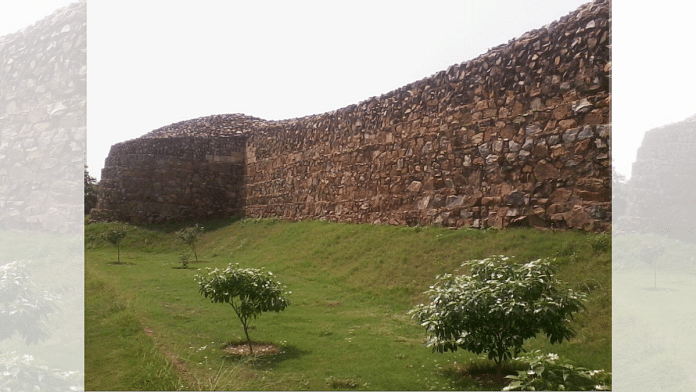Thank you dear subscribers, we are overwhelmed with your response.
Your Turn is a unique section from ThePrint featuring points of view from its subscribers. If you are a subscriber, have a point of view, please send it to us. If not, do subscribe here: https://theprint.in/subscribe/
Delhi a city with a long and proud history and natural beauty has become almost unlivable.
The Ridge once a 52-kilometre stretch of continuous forest, teeming with wildlife—foxes, hares, wild pigs, blackbucks, chinkaras, jackals, peacocks, nilgai, hog deer, and even leopards and hunting lodges where, Mughal emperors, royal courtiers, and later British officers embarked on extravagant hunts, accompanied by elephants, horses, and a retinue of attendants.
Never before has the Ridge been in such a deplorable state. From this virtual green, it must return to being truly green. Reviving the Ridge is not just a conservation goal; it is essential for making Delhi livable once more.
It was the river Yamuna and its fertile banks that first drew the Pandavas to settle here, and over the centuries, many rulers and dynasties followed. They revered the river, lived by its rhythms, and ensured its care.
Only in recent times we began to violate what we once worshipped. The same Yamuna that quenches our thirst and receives our prayers is now choked with sewage, industrial waste, and the remains of cremated bodies.
Today, the Yamuna is biologically dead—a foul-smelling reminder of our negligence. Yet, it remains a vital artery in Delhi’s ecosystem.
Restoring this vital artery is not just an act of environmental repair, but one of collective redemption. With thoughtful restoration and community will, this ancient river can breathe again—bringing life, balance, and dignity back to our city.
The massive ruins of Tughlaqabad Fort, the ancient walls and gates of Purana Qila, and the fortifications of Siri Fort stand as powerful reminders of Delhi’s former grandeur, markers of the city’s rich cultural heritage, vital to its identity and attract tourists from around the world, generate employment, and contribute significantly to the local economy.
To heal ailing Delhi—and restore the charm once lent by its carved monuments, peaceful forests, sacred temples, and the clean, gushing Yamuna—we need dedicated efforts, out-of-the-box thinking, holistic development, effective systems management, corruption-free services, and a sense of collective responsibility shared by both the authorities and Delhi’s vast population.
Delhi was once a living painting, brushed with five vibrant colours — green from the Ridge forests, blue from the Yamuna, brown from its ancient and forgotten quarters, yellow from its holy and spiritual places, and red from Humayun’s Tomb, the Red Fort, and other still-thriving historical landmarks. Today, that canvas has turned mostly grey and black. For our own sake, we must restore it to its original splendour.
Delhi lovers — those who understand that Delhi is not merely a city but a living, breathing treasure trove of history, nature, and spirit — must show ecological responsibility, become fiercely active, both in public and private spaces. Every building should be mandated to install traditional Rajasthani tankas, age-old systems of rainwater harvesting, to meet drinking water needs sustainably and a shared commitment to not only love our homes, colonies but the city as a whole just as the Romans cherished Rome, the Catalonians embraced Barcelona, and the Athenians revered Athens.
These give Delhi its magic and beauty, and inspire people to explore and fall in love with the city.
To help people experience this beauty, the author suggests 10 special heritage walks, each suited to a particular season:
🌸 Spring
Qila Rai Pithora – the first known city of Delhi.
☀️ Summer
Central Ridge Forest – full of greenery and shade.
🌧️ Monsoon
Tughlaqabad and Jahanpanah – the rainy season brings these ruins alive.
🌤️ Post-Monsoon
The Yamuna floodplains and Firuzabad – beautiful after rains.
❄️ Winter
Dilli Sher Shahi, Chandni Chowk, Mutiny Memorials, and Asola Wildlife Sanctuary – perfect for cool weather walking and sightseeing.
🚶♂️ Getting Ready for a Nature Walk
To make the most of your walk, you should dress properly and carry the right items.
👕 Clothing:
Wear dull-colored clothes (not bright or flashy).
Full-sleeved shirts and full-length pants (no loose ends).
In summer: wear a straw hat and dark sunglasses.
In monsoon: carry a raincoat (umbrellas not recommended).
Shoes: Wear high boots or sneakers with socks.
🎒 What to Carry:
A water bottle to stay hydrated
A light meal (like sandwiches, fruits, or tea)
A pair of binoculars to spot birds and animals
A camera with extra film – try to take multiple shots of each scene, use high-speed film, and keep shutter speed around 1/250 sec
A field guide book (to identify birds, animals, or plants)
A notebook and pen/pencil to jot down your observations
🌿 Conclusion: Fall in Love with Delhi
Delhi is more than just a capital city—it’s a living museum, a garden of history, and a treasure of nature. The more we explore it, the more we appreciate its beauty, history, and spirit. By discovering and caring for Delhi, we ensure that future generations too will love and protect this magnificent city.
These pieces are being published as they have been received – they have not been edited/fact-checked by ThePrint.


